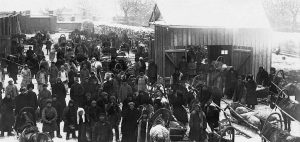Requisitions and Dispossession in Cheliabinsk, 1919.
From https://russiainphoto.ru/
By Drake Long
OXFORD – Students were pressed Monday, October 10, to think about the idea of experiencing a revolution. Miami University’s Havighurst Colloquium speaker series continued this week with a lecture by Dr. Anne O’ Donnell, an Assistant Professor of History from New York University. Her topic, titled ‘Seizing Power: Possession and Property in the Revolutionary Republic, 1917-1922,’ encouraged students and attendees to think about the phenomenon of dispossession, looting, and property theft during the formative years of the Soviet Union.
O’ Donnell told the story of a woman named Tikhobrazova, a citizen who fled Petrograd prior to the Russian Civil War only to return after and find her property gone. The process of getting it back was what captured O’ Donnell’s attention. The new state seizing property was a fairly common occurrance, but O’ Donnell challenged calling this case one of pure nationalization. “Local governments followed the national government’s lead, calling it ‘municipalization,” she said in reference to the lesser-known bureaucracies that emerged all over Russia after October 1917, especially in the biggest cities, that pursued social welfare mandates without ever being registered or acknowledged by the Bolsheviks themselves. In Tikhobrazova’s case, she had to appeal first to a “Troika on Requisition and Confiscation,” and when her request for her property was denied, she appealed to the “Presidium of the Petrosoviet.” Despite the Presidium’s intervention, she was denied once more, and had to appeal to both a “People’s Court” and the “People’s Court of the First City Neighborhood, 4th Department.” The multitude of names represents part of the institutional confusion, described by O’Donnell, that Soviet citizens felt. These names and the new bureaucratic language of the Soviet state were in Russian, yet completely alien to most citizens. The impenetrable sphere of bureaucratization can also be detected when Tikhobrazova is allowed to see the warehouse where her things are kept, only to be denied at the door by the manager. Distraught, Tikhobrazova cried until a worker, in an act of kindness, retrieves her scrapbook for her.
What happened to Tikhobrazova’s property, in the end? O’Donnell stated how it was scattered amongst so many departments and people that simply finding it was impossible for the smaller bureaucracies whose job it supposedly was, and the image of warehouses rotting full of other peoples’ property underscores how bad the inefficiencies in the new institutions were. But pointing out the ineptitude of the municipalization is short of O’Donnell’s main point.
In her lecture, she stated, “Dispossession is common to virtually all revolutions, but not all revolutions are founded on dispossession.” According to O’Donnell, the looting, seizure of property, and ‘Red banditry’ so endemic during the Civil War were a cause of the Bolshevik’s very ideology: the revolution was borne out of a hatred for private property, and in such circumstances looting became the primary means for people outside the Bolshevik sphere to express their revolutionary spirit.
In the destruction of private property, the Soviet state established ‘new norms’ of possession that would be determined by the bureaucracy, and doled out by resources owned by the bureaucracy. According to O’Donnell, this had yet another concurrent effect. Tikhobrazova, offered the new norm in place of her old property, was no longer entitled to ‘her’ possessions. She was simply entitled to whatever the state could give her. The relationship between people and their things was utterly torn down, replaced by the mindset that all property was temporary, and insecure. “No form of possession was stable,” O’ Donnell stressed, mentioning how even high-ranking Soviet members would find their possessions stolen. Ironically, O’Donnell mentioned, this was the very attitude that led to Vladimir Lenin, the founder of the Soviet state, being “dispossessed” (O’Donnell called it a “carjacking”) of his car at one point.
In the atmosphere of “institutional cacophony,” as O’Donnell named it, and with the phenomenon of dispossession sweeping all over revolutionary Russia, O’Donnell stressed that the events of people such as Tikhobrazova weren’t aberrations, but rather normal experiences in the Soviet state. The experiences of the revolution and the Civil War were legitimated only by having been dispossessed of something. Tellingly, O’Donnell noted at the end of her lecture, as Bolshevik power reached the borderlands of the new Russia, especially in Central Asia and Ukraine, the looting phenomena began again, as if it was a necessary step on the transition to membership in the coming Soviet Union.
Drake Long is a senior majoring in diplomacy and global politics at Miami.


1 Response to Seizing Stuff in Revolutionary Russia